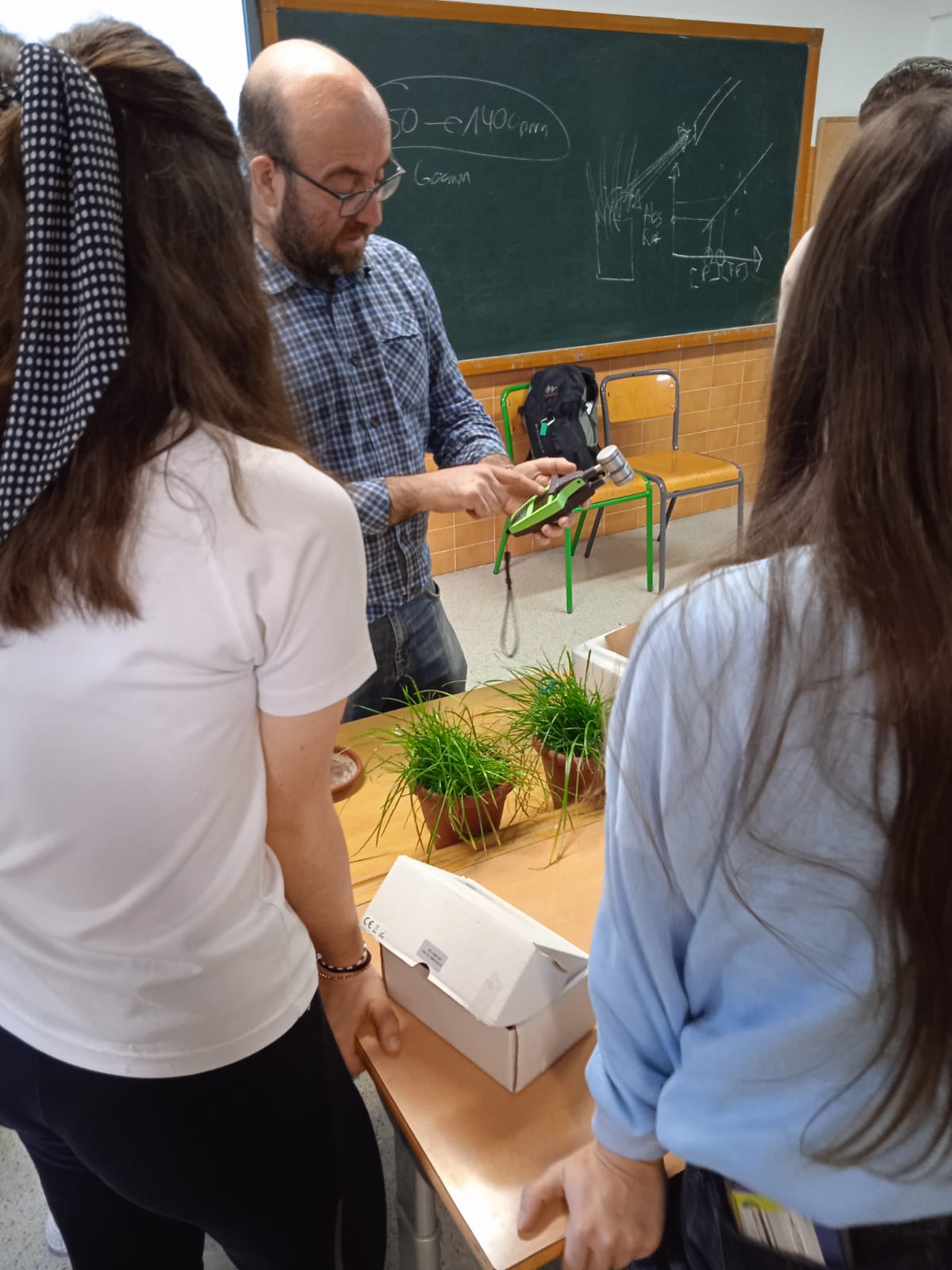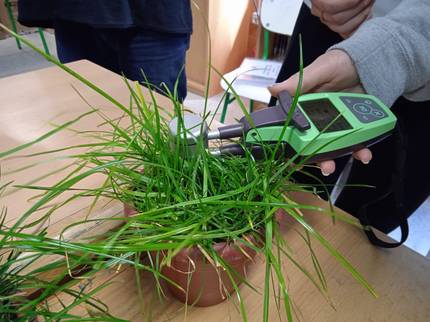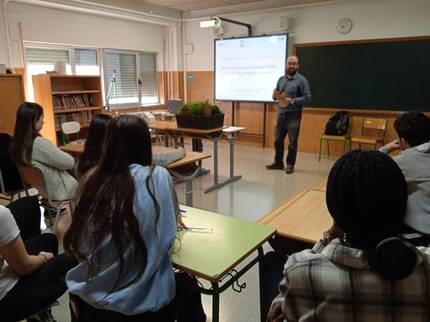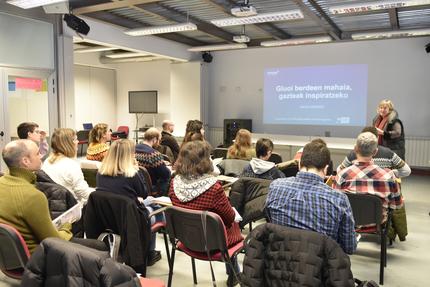"If you change your car for a bike to ride 200 meters, we've done something."
2023/12/06 STEAM-Hezkuntza (Elhuyar Zientzia)
The 4th ESO students at IES Aralar de Alegia, together with the researcher at the Instituto Navarro de Agrobiología at CSIC Iker Aranjuelo Mitxelena, have analyzed the air quality at different points in Tolosaldea, analyzing the plants through biomonitorization, within the project “Mesa de los Gluones to inspire young people”. Iker Aranjuelo tells us about research and this experience.

"Exploring air quality" is the title of your project. What does that mean? What is the project?
It involves investigating air quality through biomonitoring. That is, we use plants to measure heavy metals in the air. Cars, buses or lorries release small particles that remain in the air. They stand anywhere: in our clothes, in the ground, in the trees, in the leaves of the plants…
In fact, we use the Italian herb Llollollobelar (Lolium multiflorum) to carry out the investigation, that is, the herb found in the football fields.
The project is now complete. The FECYT (Fundación Española de Ciencia y Tecnología) funds, among others, the scientific projects of citizenship, and within this framework we carry out our research.
In total, 400 plants were distributed in cities and towns of Navarra, Gipuzkoa and Bizkaia. The goal was to work with areas of different density to see the differences. For a while, the neighbors and neighbors who participated had plants in their homes. Subsequently, plant samples were collected and investigated in the laboratory to measure the amount of heavy metals. Of the 400 pots that were distributed, we investigated 320.
What conclusions did they draw?
When starting statistical analysis, it has been observed that there is a direct relationship between the number of inhabitants and the concentration of these particles. That is, the higher the population, the higher the concentration of particles. And vice versa. The lowest values are found in the smallest villages.
There are exceptions. For example, in Alegia, at one point, more heavy metal particles have been collected than expected. Despite being an area of low population and mountain, one kilometer away runs the N-1 straight line, of high traffic. Something similar happened in Zizur Mayor. With a population of around 15,000 and a high level of particles, it has a motorway to Estella, where 70,000 cars, buses, trucks, etc. circulate daily.
In cities, it's also different neighborhood to neighborhood. In Pamplona, for example, the highest values are found in the centre and in the avenues that address industrial areas. However, in mountain neighborhoods, air quality is better.
The comparison between San Sebastian and Pamplona is also curious. Although Pamplona is more populated than San Sebastian, the number of particles is higher in San Sebastián. The massive influx of people into San Sebastian by neighboring towns and the massive arrival of tourists by car increase the number of particles.
That is, in general, in the areas with the highest number of inhabitants there are more particles, but if despite being a small town has a very busy area, the number of particles is higher.
Poor air quality influences our health, right?
That's what it causes. The truth is that we do not perceive the damage at the moment, but in the medium or long term. I mean, you can be practicing sports in a very polluted area, and maybe 30 years later you'll be more likely to develop some disease later, or not. Each body can respond in one way or another.
My message is that overall the air quality in our environment is good. In some places it's not bad, but it's not good either. With this in mind, we should reflect on the type of transport we use to access areas of large public and traffic flows. We spend the day with our car and then we go home, but in these areas live people who will breathe for twenty-four hours. Changing habits is in everyone's hands to change the situation.
With the Mesa de los Gluones project you have launched your research project in schools. Last year he spoke to the young people of IES Aralar de Alegia. What did they do?
Teachers and volunteer students from the Alegia Institute have participated.
In the first session, we distributed the pots to them and held them in their homes for two months. During this time, students and teachers took several measurements at home. To do this, Joseba Aldasoro Galan, Elhuyar's STEAM Education technician, distributed temperature and precipitation measurement devices. Also a research notebook. Students and teachers introduced the data into a digitally shared document.
In the second session, we took the plants in class and took them to the lab. We sent the lab results to the faculty to work in class. Because there's a lot of data, we send the data to them in a color table to make it easier to visualize. It is important that this first interpretation be made by itself, because we believe that they are more involved in the process.
Finally, in the third session, the students presented the conclusions and, among them, we held an analysis session. We came to similar conclusions: that private transport affects the air quality that we breathe people.
Have you had anecdotes in this experience of the IES Aralar de Alegia?
Yes, and it has served to learn. Some students, with good intent, took the plant out of the pot so that the wind did not throw the pot and put it on the ground. We have not been able to use these plants for research. On the one hand, for the investigation, all plants must be in the same condition and, on the other, these plants placed in the soil could receive heavy metals not only from the air but also from the soil. Because with the rain, these particles don't disappear, they go to earth.
Were the results of the investigation publicly presented, no?
Yes. The youth had a stand at the Gipuzkoa fair in Tolosa and at the Elhuyar Zientzia Azoka in Bilbao. It's very enriching to tell people their experience. Both students and teachers appreciate their participation in fairs very positively.
How do teachers participate in this whole process?
The first step is for the teacher to explain the project to the students and find volunteers. Once the process is started, the professor's task is to guide the students: to follow up and help the students in the interpretation of the data. And it must also coordinate with me.
What did the students receive?
I really liked it. In this case they have been volunteers and have made a special effort. They've shown a lot of illusion, energy and interest. When I teach in college, I often miss students.
It would be interesting to be able to continue working on extending the conclusions. That is, that students, for example in social networks, make the research known to have a greater influence among young people.
How important is the relationship between students and researchers?
I do not know whether what he has done will help a student work in the future in research, but if we have managed to influence his life a little I am glad. For example, if to travel 200 meters away the car is replaced by the bicycle, we have done something.
Your team's researchers also took part in a session with young people.
Garazi Ezpeleta and Dorra Fakhet came from my team. In that we tried to make a special force, but in my team there are no women vasco-speakers. Science is not about sex. That is what we want to convey to young people. Garazi and Dorrak explained what we do in the lab and brought several devices for it.
How do young people appear?
I tell you I'm from Oiartzun and a researcher at CSIC. People think that CSIC is only in Madrid and it is not. We work in Mutiloa. What do I mean by this? That I am from Oiartzun and that I work here so that the students see that the Basques are also researchers. You can be too.
You have done this research for the first time in Alegia, and you will do this course in Usurbil and Beasain. For the future, can it be interesting that other educational centers in the Basque Country do this research?
Yes. I think it has more influence to work in schools and in small groups than to offer a multitudinous session of 200 people. It is very interesting that other centers join this research, thus expanding the scope of research and contributing to the dissemination of research findings among young people.
To deepen the content and learn more about the research of Iker Aranjuelo, you can listen to the interview held at the Ekoscan session on October 30, 2023.
For more projects in the classroom on sustainability with young people see brochure.
This project, promoted by Elhuyar, is supported by the Department of Economic Promotion and Strategic Projects of the Provincial Council of Gipuzkoa.

Gai honi buruzko eduki gehiago
Elhuyarrek garatutako teknologia






